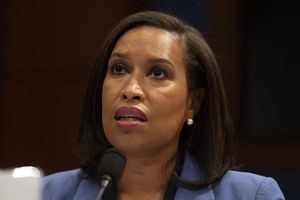On October 16, 2025, Washington D.C. found itself at the center of a political storm that combined high-stakes international diplomacy, a grinding government shutdown, and dramatic moments on Capitol Hill. The day was packed with consequential meetings, heated debates, and a rare show of unity among journalists—each event underscoring the intense pressures facing the nation.
In the White House, President Trump was busy juggling two of the world’s most watched leaders. According to The Hill, Trump spoke directly with Russian President Vladimir Putin to discuss the ongoing war in Ukraine. The timing was anything but coincidental. Just a day later, Trump was set to host Ukrainian President Volodymyr Zelensky at the White House for a critical conversation about U.S. military aid—specifically, the possible transfer of Tomahawk missiles to Ukraine. These discussions came on the heels of a new Russian assault, as energy facilities across Ukraine were targeted by Russian forces on October 16. The attacks appeared to be a pointed message ahead of Zelensky’s visit, raising the stakes for both leaders and keeping the world on edge.
Trump’s recent interactions with Putin were marked by visible frustration. Their last face-to-face in Alaska, back in August, had yielded no real progress toward ending the war. Trump, never one to mince words, publicly criticized Putin’s ongoing aggression, stating earlier in the week that the conflict was "making Russia look bad." The proposed idea of a meeting between Putin and Zelensky, which some had hoped would be a breakthrough, had so far failed to materialize.
But international diplomacy wasn’t the only drama unfolding. Back in the halls of Congress, the U.S. government shutdown dragged into its 16th day. Senate Republicans, led by Majority Leader John Thune (R-S.D.), unveiled a new tactical maneuver: forcing a vote to fund the Pentagon for an entire year. This was no ordinary budget bill. The Pentagon funding proposal had already passed committee with strong bipartisan support—26 to 3, according to The Hill—and would ensure military paychecks continued to flow despite the wider shutdown. However, the move put Democrats in a tough spot. Supporting the bill could be seen as caving to Republican tactics, while opposing it risked being painted as anti-military.
To further complicate the calculus, the Senate also prepared to consider a measure that would allow lawmakers to conference with the House on a three-bill “minibus” package, greenlit earlier in 2025. Thune and his Republican colleagues were also eyeing the possibility of attaching additional spending bills to the Pentagon measure, increasing the pressure on Democrats to respond.
As if that weren’t enough, the shutdown’s human cost was coming into sharp focus. Russell Vought, Director of the Office of Management and Budget, warned that more than 10,000 federal employees could ultimately be laid off by the Trump administration if the impasse continued. The economic and personal toll was growing by the day, sparking calls for urgent compromise. Former Senator Joe Manchin, speaking at the upNEXT LeaderForce Forum, urged Trump to lock party leaders in a room and refuse to let them leave until a deal was struck. "If he can sit down with Hamas and the Israelis but won’t sit down with Democrats and Republicans, we got a problem. … Bring us together, I think people are dying for that," Manchin said, according to The Hill.
The shutdown also drew sharp criticism from across the political spectrum. Former House Speaker Newt Gingrich, speaking on Fox Business Channel, called Senate Majority Leader Chuck Schumer’s shutdown strategy "bad for the country, bad for the Democratic Party." The comment reflected growing frustration—even among some conservatives—that the prolonged standoff was causing harm beyond the Beltway.
Meanwhile, a separate but equally dramatic scene played out at the Pentagon. Nearly every major news outlet’s Pentagon correspondent turned in their badges and staged a mass walkout on October 15, refusing to sign new press restrictions imposed by Defense Secretary Pete Hegseth. Only the right-wing One America News Network agreed to the new rules. The collective action sent a powerful message about the importance of press freedom and transparency, especially during a period of heightened national tension.
Elsewhere in Washington, President Trump announced plans for a striking new architectural project: an arch to be built near the Lincoln Memorial, serving as a formal entrance to the nation’s capital along the Arlington Memorial Bridge. The announcement, covered by The Hill, was seen as a symbolic gesture—perhaps an attempt to leave a lasting presidential legacy amid the turbulence of his second term.
As the sun set on October 16, attention shifted to two high-profile state-level debates. In Virginia, Democratic attorney general nominee Jay Jones faced off against incumbent Republican Jason Miyares at 6 p.m. Jones’s campaign had been rocked by leaked text messages from 2022 in which he discussed wishing violence against a Republican politician and his family. He apologized for the remarks but continued to face calls from Republicans to withdraw from the race. Meanwhile, in New York City, mayoral hopeful Zohran Mamdani was set to debate former Governor Andrew Cuomo, running as an independent, and Republican nominee Curtis Sliwa. These debates, livestreamed for public viewing, underscored the fierce competition and shifting dynamics in local politics.
Of course, the day wasn’t without its flashpoints. Former Speaker Nancy Pelosi found herself in a heated exchange with a reporter from LindellTV, a network founded by Trump ally Mike Lindell. The reporter pressed Pelosi on a debunked claim that she had denied requests to send the National Guard during the January 6 attack. Pelosi, clearly exasperated, told the reporter to "shut up." Her spokesperson, Ian Krager, later issued a statement to The Hill: "Numerous independent fact-checkers have confirmed again and again that Speaker Pelosi did not plan her own assassination on January 6th. The ongoing attempts to whitewash the deadly insurrection are shameful, unpatriotic and pathetic."
As the shutdown ground on, ordinary Americans watched and waited. The House was out, the Senate was in, and President Trump was scheduled for an afternoon announcement from the Oval Office. Across the country, "No Kings" demonstrations were planned for Saturday to protest the Trump administration, while the National Transportation Safety Board released a report finding that the Titan submersible had failed to meet manufacturing safety standards.
It was, by any measure, a day that captured the chaos, conflict, and complexity of American politics in 2025. Every headline—from the White House to the Pentagon, from the Senate floor to the city streets—told a story of a nation at a crossroads, wrestling with its future and its place in the world.
As the dust settled, one thing was clear: the decisions made in Washington this week would echo far beyond the capital, shaping the lives of millions for months and years to come.



